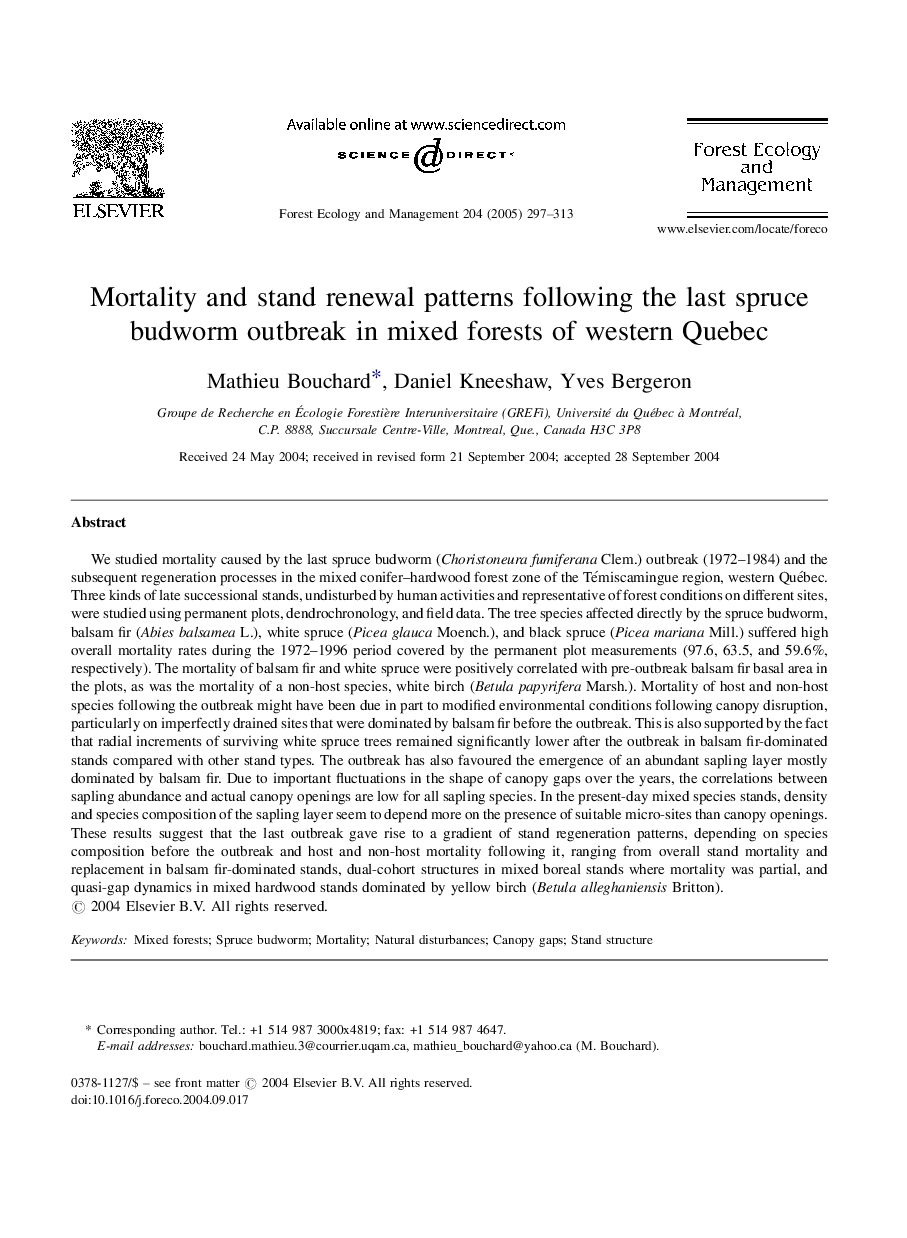| کد مقاله | کد نشریه | سال انتشار | مقاله انگلیسی | نسخه تمام متن |
|---|---|---|---|---|
| 9620534 | 159443 | 2005 | 17 صفحه PDF | دانلود رایگان |
عنوان انگلیسی مقاله ISI
Mortality and stand renewal patterns following the last spruce budworm outbreak in mixed forests of western Quebec
دانلود مقاله + سفارش ترجمه
دانلود مقاله ISI انگلیسی
رایگان برای ایرانیان
کلمات کلیدی
موضوعات مرتبط
علوم زیستی و بیوفناوری
علوم کشاورزی و بیولوژیک
بوم شناسی، تکامل، رفتار و سامانه شناسی
پیش نمایش صفحه اول مقاله

چکیده انگلیسی
We studied mortality caused by the last spruce budworm (Choristoneura fumiferana Clem.) outbreak (1972-1984) and the subsequent regeneration processes in the mixed conifer-hardwood forest zone of the Témiscamingue region, western Québec. Three kinds of late successional stands, undisturbed by human activities and representative of forest conditions on different sites, were studied using permanent plots, dendrochronology, and field data. The tree species affected directly by the spruce budworm, balsam fir (Abies balsamea L.), white spruce (Picea glauca Moench.), and black spruce (Picea mariana Mill.) suffered high overall mortality rates during the 1972-1996 period covered by the permanent plot measurements (97.6, 63.5, and 59.6%, respectively). The mortality of balsam fir and white spruce were positively correlated with pre-outbreak balsam fir basal area in the plots, as was the mortality of a non-host species, white birch (Betula papyrifera Marsh.). Mortality of host and non-host species following the outbreak might have been due in part to modified environmental conditions following canopy disruption, particularly on imperfectly drained sites that were dominated by balsam fir before the outbreak. This is also supported by the fact that radial increments of surviving white spruce trees remained significantly lower after the outbreak in balsam fir-dominated stands compared with other stand types. The outbreak has also favoured the emergence of an abundant sapling layer mostly dominated by balsam fir. Due to important fluctuations in the shape of canopy gaps over the years, the correlations between sapling abundance and actual canopy openings are low for all sapling species. In the present-day mixed species stands, density and species composition of the sapling layer seem to depend more on the presence of suitable micro-sites than canopy openings. These results suggest that the last outbreak gave rise to a gradient of stand regeneration patterns, depending on species composition before the outbreak and host and non-host mortality following it, ranging from overall stand mortality and replacement in balsam fir-dominated stands, dual-cohort structures in mixed boreal stands where mortality was partial, and quasi-gap dynamics in mixed hardwood stands dominated by yellow birch (Betula alleghaniensis Britton).
ناشر
Database: Elsevier - ScienceDirect (ساینس دایرکت)
Journal: Forest Ecology and Management - Volume 204, Issues 2â3, 17 January 2005, Pages 297-313
Journal: Forest Ecology and Management - Volume 204, Issues 2â3, 17 January 2005, Pages 297-313
نویسندگان
Mathieu Bouchard, Daniel Kneeshaw, Yves Bergeron,